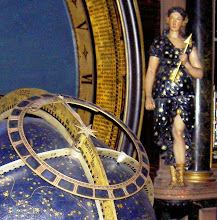 "Find out how your Water Works!" said the email. It was from our water company, and I had to think for a while before I remembered how on earth they had come across my email address.
"Find out how your Water Works!" said the email. It was from our water company, and I had to think for a while before I remembered how on earth they had come across my email address.It all started with the premiere of "The Age of Stupid" in our city: Lunchista was asked to make up the numbers for a press stunt on the river bank. In the event our local eco-enthusiast par excellence turned up on his bike with the usual trailer full of cadged wood bits for his stove and stole the show, so I needn't have bothered. Except that, watching his small daughter skipping stones into the river, and totally innocent of our activities, was a bloke called Dave. We got talking, it turned out he worked at the water company and I happened to be curious about where our used water goes, so I gave him my email address.
The email offered a choice of times, so I chose the quietest, mid-afternoon during the working week. They'd booked one of the corporate-type meeting rooms (complete with bar) at the race-course. Togged up for a bike-ride to a working site, Lunchista felt distinctly under-attired for such a posh venue. But it was either that or wading through pools of muck in my green velvet cocktail dress and tiara. No contest, really.
The opener was one of those bland and eminently forgettable corporate films, following a perfect and immaculate family as they go through their perfect and immaculate day using whatever it is that the company provides. I'm sure there are college courses in making those videos.
Then things got interesting. Stepping off the coach at the site you're hit by the smell: the drop-off point happens to coincide with the part of the site where the waste water arrives. Mostly it's from the city's loos, but when there are floods some of the water washed off the streets gets in here too. The main contributor to this hum, though, was the grille that separated out all the insoluble things that people, in their absent-mindedness, flush down the loo. These all end up in a skip, from which, our guide told us, someone's false teeth were once retrieved...and they carried on using them!
Next stop was a giant metal shed in which lurks an Anaerobic Digestor. The stuff putrifies and gives off Methane, which is caught, purified (for example there's some Sulphur in there that has to go), and then used in essentially a miniature gas-fired power station. The electricity from this powers most of the rest of the site, and the heat is piped off to be used in one of the other processes further down the line. The stuff is now "sludge", which is a lot less unpleasant than before, but still brown and murky. The bacteria that start to digest this seem to work like a "yeast plant", in which some is tapped off at the far end and re-used to start the process off at the input end.
By now I was either getting used to the smell, or in the grips of sinusitis again. Or else perhaps it really was the case that this bit of the site was just plain less smelly. After that it was time for a spot of aerobics (not for us, but for the sludge). This stage is polished off in the bit of a sewage works that everybody's seen, in which water-jets come out of long gantries that sweep slowly round a giant circular pool. We came up to the edge of the 50-yard wide pool, and the water coming away was clear. It smelled slightly "earthy", but that might just be because we're all used to a spot of Chlorine these days.
I got out my camera for what would have been a terrific shot of the circular pool reflecting our city's two famous landmarks (the Minster and the old Chocolate Factory) and the absolutely cloudless sky...but no photos were allowed on site, and they didn't sell postcards, so I'm afraid you'll have to make do with a picture of our tour-guide's file. Which is a pity, because they also have something of a wildlife reserve, next to where all the solid results of the enterprise are composted in long rows. There's an arrangement whereby local farmers can ring up and ask for deliveries of the end result, to use as fertiliser. With no heavy industry (not even chocolate manufacture) in the vicinity, this stuff remains refreshingly free of things like Cadmium, which were a problem in other places in the past. It also means we get to keep things like Phosphorus and Iodine, without which the whole of life on land would collapse, swiftly followed of course by Lunchista's house price.
I also noticed there were no flies on the site. And it was spotless. And all this for only 17 million quid, the sort of sum they find down the back of the sofa during a bank bail-out.
Small price to pay to stop the country going down the toilet.


No comments:
Post a Comment